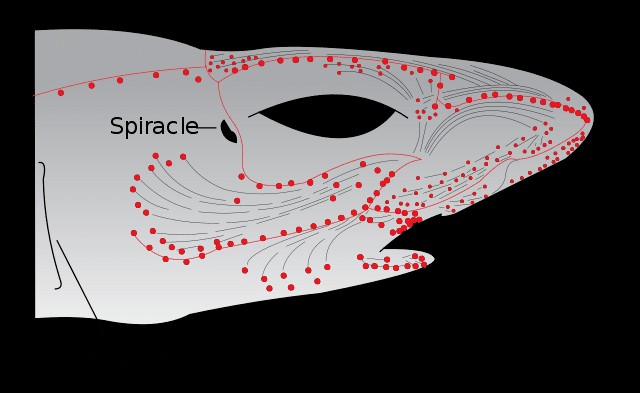Sharks, the ocean’s apex predators, have thrived for over 500 million years, surviving multiple mass extinction events. Their success lies in their perfectly evolved hunting strategies. But how do sharks hunt for food so effectively? The answer lies in a sophisticated suite of senses that allows them to detect, track, and capture prey with remarkable precision. This article delves into the sensory arsenal of sharks, revealing how each sense contributes to their predatory prowess.
Long-Range Detection: Hearing and Smell
Sharks possess exceptional long-range senses, primarily hearing and smell, which enable them to detect potential prey from considerable distances.
Hearing: Sharks have a highly developed auditory system that provides crucial information about potential prey long before they are within visual range. They are particularly attuned to low-frequency sounds, such as those produced by wounded or struggling fish. Remarkably, sharks can detect these sounds from distances exceeding a kilometer. This ability to pinpoint the source of distress signals allows them to quickly locate vulnerable prey.
Smell: The olfactory sense of sharks is legendary. The common saying about sharks detecting a drop of blood in an Olympic-sized swimming pool isn’t far from reality. A shark’s sense of smell, or olfaction, is exquisitely sensitive to amino acids in proteins, such as those found in blood. Studies have demonstrated that sharks can detect as little as one part per 20 million parts of water. This exceptional olfactory capability is likely one of the primary senses that alerts sharks to potential prey from a distance, initiating the hunting sequence.
Mid-Range Identification: Vision and Mechanosense
Once a potential target is within medium range, sharks rely on vision and a unique sense called mechanosense, facilitated by the lateral line, to gather more information.
Vision: Contrary to some misconceptions, sharks possess good eyesight, at least compared to other fish. While they lack color vision and perceive the world in black and white, their visual sensory equipment allows them to create focused images. Water conditions significantly impact their visual acuity. In low-light or murky waters, their ability to see clearly is reduced.
Lateral Line – Mechanosense: This extraordinary sensory system, foreign to humans, consists of a series of canals located along the shark’s body with openings to the skin. These canals allow water to enter and are highly sensitive to water movements and vibrations. This allows sharks to detect subtle disturbances created by wounded or struggling fish, further aiding them in pinpointing potential prey. The lateral line essentially provides sharks with a “sixth sense” that detects pressure changes in the water.
The Lateral Line System allows Sharks to sense movement and vibration in the water.
Close-Range Precision: Electrosense, Touch, and Taste
As the shark closes in on its prey, its short-range senses, including electrosense, touch, and taste, come into play to ensure a successful capture.
Ampullae of Lorenzini – Electrosense: This sense allows sharks to detect the weak electrical fields generated by all living organisms. Countless small pores, known as the ampullae of Lorenzini, are concentrated around the shark’s snout and are filled with a conductive gel that amplifies these faint electrical signals. This highly sensitive electroreception allows sharks to detect prey, even when it is completely hidden, such as buried in the sand. Electrosense is most effective at close range, typically within one meter.
 ampullae of lorenzeniThe Ampullae of Lorenzini helps Sharks find hidden prey by sensing electrical signals.
ampullae of lorenzeniThe Ampullae of Lorenzini helps Sharks find hidden prey by sensing electrical signals.
Touch: In the final stages of the hunt, sharks often use touch to investigate potential prey. Lacking hands, they may bump or nudge the object with their snout or even “feel” it with their mouths. This behavior is the reason behind the often-reported “bump and bite” scenario. Divers are often advised not to let sharks bump into them, as this is frequently followed by a test bite.
Taste: Like humans, sharks possess taste buds in their mouths, which provide the final assessment of whether they have found a meal or made a mistake. While we don’t know precisely what sharks find palatable, the relatively infrequent occurrence of shark-human interactions resulting in more than a single bite suggests that humans are not a preferred food source.
Conclusion: A Symphony of Senses
In conclusion, how do sharks hunt for food is a complex process that relies on a suite of highly refined senses. From detecting prey kilometers away using hearing and smell to confirming its suitability with taste, each sense plays a critical role in the shark’s predatory success. These sensory adaptations, honed over millions of years, make sharks formidable hunters and essential components of marine ecosystems.
Want to witness these incredible senses in action? Consider joining a shark diving tour to observe these magnificent animals in their natural habitat.
Explore Shark Diving Tours
- Tiger Beach Shark Diving
- Oceanic Whitetip Shark Diving
- Great Hammerhead Shark Diving